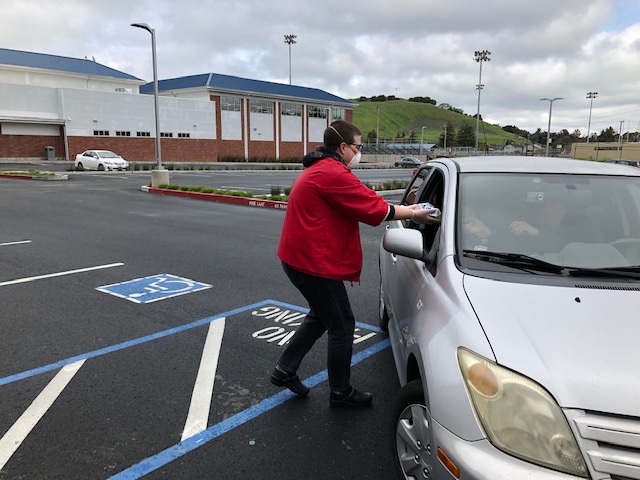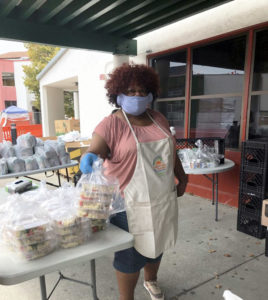
Black teachers: How to recruit them and make them stay

Lessons in higher education: What California can learn

Keeping California public university options open

Superintendents: Well-paid and walking away

The debt to degree connection

College in prison: How earning a degree can lead to a new life

As students gradually return to classrooms, advocates and lawmakers say it’s more important than ever to provide free meals in schools without burdensome eligibility requirements, just as California has done during the pandemic.
The “Free School Meals For All” bill, SB 364, introduced last month by East Bay Sen. Nancy Skinner, D-Berkeley, would establish a statewide Universal Meal Plan starting in the 2022-2023 school year. It would guarantee free breakfast and lunch for all California students and eliminate the application process that proved a barrier to many families. Though New York City, Chicago and other U.S. cities have created such programs, California would be the first to do it statewide.

Sen. Nancy Skinner, D-Berkeley
“If students come to class hungry, it’s harder to learn,” Skinner said. “There’s a lot of reasons why a child may come to school hungry; they might just not have had time to pack a lunch. Why should we have to go through a whole bureaucratic hassle to get the kid fed when we could just have universal meals?”
Skinner presented the bill Tuesday at the California Senate Standing Committee on Education where it was met with unanimous bipartisan support and no opposition. Representatives from the California Teachers Association, California School Employees Association, and Service Employees International Union all backed the bill, which will be heard next by the Senate Standing Committee on Human Services.
The issue of food insecurity has been evident for years in Skinner’s Senate district, which includes West Contra Costa Unified serving about 30,000 students in the communities of Richmond, El Cerrito, San Pablo, Pinole, Hercules and El Sobrante, and Oakland Unified, which serves about 50,000 students.
More than 65% of students in both districts come from families who qualified for and participated in the U.S. Department of Agriculture’s National School Lunch Program, which allows low-income students to obtain free and reduced-price meals. Statewide, 3.9 million students, 63% of California’s student body, participated in the program.
However, Skinner, West Contra Costa Unified Associate Superintendent of Business Services Tony Wold and childhood hunger experts believe that the number of families in need of food assistance both in the East Bay and throughout the state is actually much higher. That’s because many families avoid the National School Lunch Program application process.
In order to participate in the program, families must disclose how much money the family makes, how many people live in the household, their children’s immigration status or if their children are homeless or runaway. Wold said some families fear having that information on the books, and that students may feel embarrassed to receive a free meal while others pay for it.
The result has been a yearly decrease of about 1% in the number of West Contra Costa Unified students who participate in the program, Wold said.
“Sometimes the kid just doesn’t want to be seen getting a free lunch, because it’s a status issue for them,” Wold said. “Others, the family just doesn’t think it’s your business what they make or don’t make. There’s a lot of different reasons for it, psychologically.”
Schools in New York City began serving free meals to all students in 2017 after finding that some students would rather go hungry than admit they didn’t have enough money to pay for lunch. The decision followed national outcry over “lunch shaming” — publicly shaming students for unpaid school meal bills, even throwing away their lunches rather than allowing them to eat.
“It removes a lot of stigma when all kids can have the meals available, and you just walk by and grab it,” said Kathy Saile, California director of No Kid Hungry, which fights against childhood hunger. “It also increases participation when you don’t have to worry about your meal card or paying the difference of a reduced price.”
The push for universal school meals isn’t limited to California. The national 50,000-member School Nutrition Association, representing nutrition services workers, has identified universal school meals as a top legislative priority for 2021. It lobbied Congress earlier this month to create a federal universal school meal program.

Photo: Ali Tadayon/EdSource
Oakland Unified food service assistant Yvonne Reynolds hands out grab-and-go meals Aug. 17 at Fremont High School.
Since the pandemic, California districts have distributed millions of free “grab-and-go” meals to students without requiring them to fill out the National School Lunch Program application thanks to a series of waivers from the U.S. Department of Agriculture.
The waivers allowed districts to be reimbursed for every meal they distributed, not just those served to students signed up for the free and reduced-price lunch program. But those waivers are set to expire at the end of September.
Skinner’s team intends to find a way to avoid having to ask families to fill out the National School Lunch Program application, but the bill’s current language calls on families to do it anyway. That’s so that the state could collect as much money as possible from the U.S. Department of Agriculture to pay for the proposed Universal Meal Plan. If families don’t fill out the application, their children would still be entitled to free meals under the Universal Meal Plan. However, fewer low-income families filling out the application could result in fewer U.S. Department of Agriculture dollars for the state.
California schools can also participate in the “community eligibility provision” under the National School Lunch Program, which allows them to offer free meals to all of their students if more than 40% of the student body qualifies.
Palm Springs Unified is one of the districts that qualifies for that provision. Nutrition services director Stephanie Bruce testified at Wednesday’s Senate committee hearing that being able to offer free meals to all students has reduced absenteeism, tardiness and hunger-related trips to the nurse’s office.
The applications are also crucial for the state’s Local Control Funding Formula, which gives additional state funds to districts based on the number of low-income students, English learners, foster children and homeless youth they serve.
Skinner’s hope is that much of the cost for the Universal Meal Plan would be covered by U.S. Department of Agriculture, since the majority of students in the state qualify for free and reduced-price lunch. She also hopes to leverage the buying power that would come with serving so many students to purchase food at a lower cost.
But the federal funding likely won’t be enough to cover the entire cost of a Universal Meal Plan, requiring the state to allocate some funding toward it out of its budget. Skinner’s team didn’t have a prediction yet as to how much that would be.
The bill will also provide grants for districts to cover the costs of purchasing whole or minimally processed food grown in California.
Editor’s Note: As a special project, EdSource is tracking developments in the Oakland Unified and West Contra Costa Unified school districts as a way to illustrate some of the challenges facing other urban districts in California. West Contra Costa Unified includes Richmond, El Cerrito and several other East Bay communities.

Panelists discussed dual admission as a solution for easing the longstanding challenges in California’s transfer system.

A grassroots campaign recalled two members of the Orange Unified School District in an election that cost more than half a million dollars.

Legislation that would remove one of the last tests teachers are required to take to earn a credential in California passed the Senate Education Committee.

Part-time instructors, many who work for decades off the tenure track and at a lower pay rate, have been called “apprentices to nowhere.”
Comments (5)
Comments Policy
We welcome your comments. All comments are moderated for civility, relevance and other considerations. Click here for EdSource's Comments Policy.
Sheila Keim 3 years ago3 years ago
There is no requirement to disclose immigration status on the federal free and reduced meal application. Does the state of California require that on the meal application? If so, why?
CFan 3 years ago3 years ago
Some of our CA school meal programs suffer massive plate waste, serve https://bit.ly/UPFproducts, and don’t require safety and fair compensation for food chain workers. Until we fix this (and we should!), why unnecessarily scale up school meal programs? Why not “Free School Meals for the Food Insecure” (instead of “Free School Meals for All”) where families participate as needed & pay if/when able?
Will 3 years ago3 years ago
If this does pass the CDE/Legislature will have to find a different way to identify low income for LCFF Supplemental/Concentration purposes. During pre-COVID times, families were “incentivized” to fill out their lunch application to get free or reduced meals, but with this “incentive” possibly gone there needs to be another way to figure out low-income status. Also impacts Title I and a host of other grants.
SD Parent 3 years ago3 years ago
Federal Title I funding as well as state LCFF supplemental and concentration grant funding are tied to parents/guardians filing income paperwork. I empathize with the reasons for this bill, but there is no such thing as “free,” and “hope” is not a funding strategy. With so much learning loss in the past year, the last thing California needs is another underfunded education mandate.
jim 3 years ago3 years ago
The bill says “freshly prepared meal” which would seem to conflict with the central food preparation used by many large districts. Looking at LAUSD meals it would be tough to describe them as “freshly prepared”